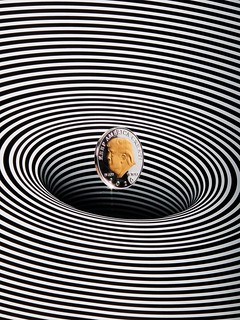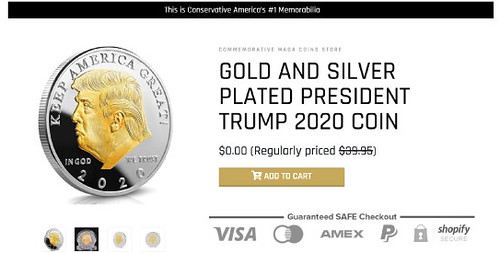
PREV ARTICLE
NEXT ARTICLE
FULL ISSUE
PREV FULL ISSUE
HOW TRUMP COINS BECAME INTERNET SENSATIONArthur Shippee and Mel Wacks passed along this New York Times story on how those Trump Coins came to dominate the Internet ad space. It's an interesting detective story and lesson in online marketing. Here's an excerpt - see the complete article online. -Editor
There's a style for every taste, each featuring a portrait of Mr. Trump. Sometimes he's rendered in gold, staring thoughtfully into the distance. In others he's smirking in silver, raising a thumb's up, or even riding a missile while a bald eagle soars behind him.
Among all the options, one version stands out. Known online as simply the
The coin itself features Mr. Trump's face embossed in gold on a base of shining silver. His slogan, It could be yours, too, for just $0. (Plus $9.99 shipping and handling.) This particular version has become something of an internet mystery. It's not obvious who's promoting it or profiting from it. It's sold by a mysterious news website about which little is disclosed. Mr. Trump has nothing to do with the coin. No identifiable company is taking credit. Some internet sleuths have followed digital bread crumbs to suss out the organizations behind the coin's popularity. The New York Times took a similar path, tracking a network of advertisers and following their activity from public storefronts to private marketing portals. Using guidance from insiders and marketing veterans, the search crisscrossed the globe, implicating a handful of companies and a legion of anonymous marketers operating in parts unknown. What became clear was not just the coin's unusual origins, but an entire disinformation supply chain that relied on falsehoods and misinformation at nearly every step. Fueling the coin's success were fake social media accounts that pushed false ads and a fleet of misleading news websites that preyed on partisan discontent. Seen in full, the coin illustrates what watchdogs have long understood: Many untruths that Americans encounter online aren't created by foreign actors trying to sow division. They simply exist to help someone, somewhere, make a quick buck. In one post, a fake account for Representative Marjorie Taylor Greene, a Georgia Republican closely aligned with Mr. Trump, shared a fake story on a fake Fox News website about a fake tweet by a fake Elon Musk, falsely claiming that Tesla's chief executive would soon accept Trump coins as payment. Merchandise has long been a part of the political culture surrounding presidential elections. But Mr. Trump's victory in 2016 created a new and more ravenous appetite for the goods. That's where the Trump coin first took shape, according to Maxwell Finn, an affiliate marketing expert and president of Unicorn Innovations. Mr. Finn was on the ground floor in 2016, advising on one of the first Trump coins of the modern political era.
That early coin
To read the complete article, see:
Wayne Homren, Editor The Numismatic Bibliomania Society is a non-profit organization promoting numismatic literature. See our web site at coinbooks.org. To submit items for publication in The E-Sylum, write to the Editor at this address: whomren@gmail.com To subscribe go to: https://my.binhost.com/lists/listinfo/esylum All Rights Reserved. NBS Home Page Contact the NBS webmaster 
|

